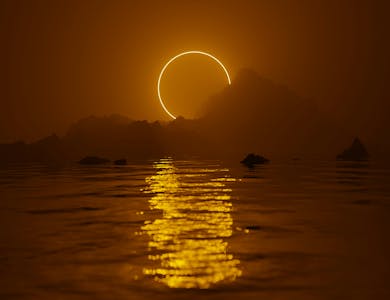Chasing Shadows
The Magic of Solar Eclipse Tourism

Chasing Shadows: The Magic of Solar Eclipse Tourism
Few natural phenomena capture the imagination quite like a solar eclipse. For a few brief, breathtaking moments, the world transforms — day turns to twilight, temperatures drop, and the sun’s blazing disc is replaced by a black orb surrounded by a halo of silvery light. It’s an experience that’s both scientific and spiritual, and for many travellers, witnessing it has become a once-in-a-lifetime goal. Welcome to the growing world of solar eclipse tourism.
What Exactly Is a Solar Eclipse?
A solar eclipse occurs when the Moon passes directly between the Earth and the Sun, casting a shadow over parts of the planet. Depending on where you are standing, you might see a partial, annular, or the most spectacular of all — a total solar eclipse, when the Moon completely blocks the Sun’s light for a few minutes.
During totality, the sky darkens, stars appear, and animals often react as if night has fallen. The Sun’s outer atmosphere, known as the corona, becomes visible — a ghostly white crown of plasma that dances in the darkness. It’s no wonder ancient cultures viewed eclipses as omens or celestial miracles.
Why Eclipses Are So Special
Solar eclipses are fleeting and rare events, visible only along a narrow “path of totality” that sweeps across specific parts of the Earth. This path changes with each event, meaning no two experiences are ever the same. For dedicated eclipse chasers — or “umbraphiles” — this uniqueness is part of the thrill.
Seeing one in person isn’t just about the view; it’s about the moment. The hush that falls over the crowd, the shared gasps as the Moon’s shadow races toward you, and the pure awe of witnessing one of nature’s grandest spectacles. It’s an emotional, almost primal experience that photos can’t quite capture.
Why Travelling with a Guide Makes All the Difference
While you can travel independently to witness an eclipse, joining a guided tour or expert-led expedition can dramatically enhance the experience. Here’s why:
Precision Planning: The path of totality is incredibly narrow — often less than 100 miles wide. Being even a few kilometres off can mean missing totality altogether. Experienced guides use detailed astronomical data and local knowledge to position you in the best possible spot for viewing.
Weather Expertise: Clouds are the eclipse-watcher’s worst enemy. Guided tours often build flexibility into their itineraries, allowing quick relocation to areas with better visibility.
Local Insight & Comfort: Specialist operators handle logistics such as transport, accommodation, and timing — leaving you free to soak in the wonder. Many guided trips also weave in cultural and natural highlights of the destination, turning an eclipse chase into a full adventure.
Educational Enrichment: Expert astronomers or local guides often accompany eclipse groups, offering fascinating explanations of what’s happening — from the Moon’s movement to the science of the corona — so you don’t just see the event, you truly understand it.
Iceland: The Land of Fire, Ice, and Celestial Light
Iceland’s dramatic landscapes make it one of the most awe-inspiring places on Earth to view a solar eclipse. With its vast open spaces, low light pollution, and sweeping horizons, you’re guaranteed a cinematic backdrop.
Picture watching the Moon’s shadow glide over snow-capped volcanoes and shimmering glaciers, reflected in mirror-still lakes. The island’s northern latitude also means longer twilight hours, creating ethereal lighting conditions perfect for photography.
Beyond the eclipse itself, Iceland offers post-event adventure in spades — from soaking in geothermal lagoons to exploring lava caves and thundering waterfalls. Combine that with the possibility of seeing the Northern Lights if you time it right, and you’ve got one of the most unforgettable trips imaginable.
The Atlas Mountains: North Africa’s Celestial Theatre
For those seeking warmth and culture alongside their astronomy, the Atlas Mountains in Morocco offer a completely different kind of magic. Their high-altitude plateaus provide clear skies and stable weather conditions — ideal for eclipse viewing.
Watching a solar eclipse here feels timeless. As the desert light fades and the peaks turn to silhouettes, you can almost sense the ancient wonder that would have filled early astronomers and Berber tribes alike.
A guided eclipse trip to Morocco can easily blend with rich cultural experiences — exploring Marrakech’s souks, visiting kasbahs, or journeying into the Sahara. The combination of science, storytelling, and scenery makes the Atlas a truly poetic setting for this celestial dance.
In Summary
A solar eclipse is a rare cosmic alignment that reminds us just how extraordinary our universe is. To stand beneath the Moon’s shadow, surrounded by others who share that same sense of awe, is a travel experience unlike any other. And by exploring eclipse destinations like Iceland or the Atlas Mountains with expert guides, you’re not just witnessing an event — you’re part of a story that connects the Earth, the Moon, and the human spirit.




